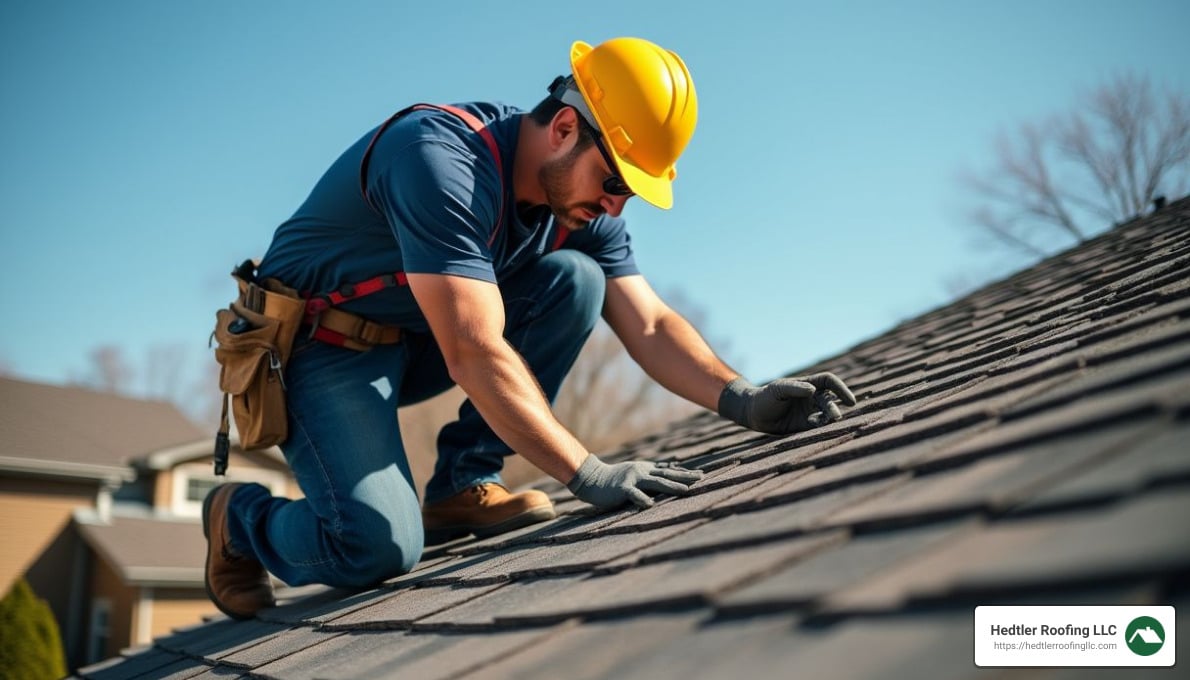Roofing Estimate 2024: Top Tips for Accurate Costs
When it comes to planning for a roof project, understanding a roofing estimate is crucial. Here’s a quick breakdown for homeowners:
- Total Roof Cost: Includes detailed sections for labor and material costs.
- Work Description: Clear outline of the tasks to be completed.
- Warranty Information: Coverage on the work done and materials used.
- Validity Period: How long the estimate is good for.
A roofing estimate ensures you budget accurately for both roof replacement and repair. It helps streamline the process, making it easier to compare quotes and choose the best contractor for your needs.
My name is Jason Hedtler, owner of Roof Experts, and I have over 20 years of experience in providing accurate and detailed roofing estimates. Whether you’re looking to replace an aging roof or repair damage, I’m here to help Massachusetts homeowners get the job done right.

Common roofing estimate vocab:
– average cost to tear off and replace roof
– roofing cost
Understanding Roofing Estimates
What is a Roofing Estimate?
A roofing estimate is a detailed breakdown of the costs associated with a roofing project. It includes labor costs, material costs, and other expenses to give homeowners a clear picture of what they can expect to pay.
Labor Costs: This covers the wages for the roofing crew. It varies based on the complexity of the job, the size of the roof, and the time required to complete the project.
Material Costs: This includes the cost of shingles, underlayment, nails, and other materials needed for the roofing project. The type of roofing material chosen can significantly impact the overall cost.
Detailed Breakdown: A good roofing estimate provides a detailed breakdown of all costs, making it easier to understand where your money is going. This transparency helps homeowners make informed decisions.
Factors Affecting Roofing Estimates
Several factors influence the cost of a roofing project. Understanding these can help you better assess and compare different estimates.
Roof Size: The larger the roof, the more materials and labor are needed, which increases the overall cost. Roof size is usually measured in square feet or squares (100 square feet).
Roof Pitch: The steepness of your roof affects the difficulty of the job. Steeper roofs are more challenging to work on and may require additional safety measures, thus increasing labor costs.

Roofing Materials: Different materials come with different price tags. For example, asphalt shingles are affordable and easy to install, while metal roofing is more durable but also more expensive. Wood shake, clay tiles, and slate roofing offer unique benefits and costs.
Additional Features: Skylights, vents, chimneys, and other roof features can add to the complexity and cost of the project. These elements require extra labor and materials to ensure they are properly installed and sealed.
Labor Costs: The cost of labor can vary based on the contractor’s experience, the complexity of the job, and the local market rates. Always ask for a detailed breakdown to understand these costs better.
By considering these factors, you can get a more accurate and comprehensive roofing estimate. This will help you plan your budget and ensure there are no surprises down the line.
Next, we will dig into how to calculate a roofing estimate, including the use of roofing calculators and templates to streamline the process.
How to Calculate a Roofing Estimate
Accurately calculating a roofing estimate involves several steps, from measuring the roof to calculating material and labor costs. Here, we’ll break down the process and explain how to use roofing estimate templates for efficiency.
Step-by-Step Calculation
1. Measurements
Start by measuring the dimensions of your roof. You’ll need the length and width of each roof section. Multiply these to get the total square footage. For example, if one section of your roof is 30 feet long and 20 feet wide, the area is 600 square feet.
2. Roof Pitch Multiplier
The pitch of your roof affects the total area you need to cover. The pitch multiplier accounts for the slope. Use a pitch factor chart to find the multiplier for your roof’s pitch. For example, a 6/12 pitch has a multiplier of 1.12. Multiply the square footage by this factor. If your roof area is 600 square feet, the adjusted area is 600 x 1.12 = 672 square feet.
3. Material Costs
Next, calculate the cost of materials. Different roofing materials have different costs per square foot. For instance, asphalt shingles might cost $4.50 per square foot, while metal roofing could be $10.00 per square foot. Multiply the total square footage by the cost per square foot to get the material cost. For 672 square feet of asphalt shingles, the material cost would be 672 x $4.50 = $3,024.
4. Labor Costs
Labor costs depend on the complexity and size of the job. Calculate labor costs by multiplying the number of workdays by the daily labor rate. For example, if your labor rate is $500 per day and the job takes three days, the labor cost is 3 x $500 = $1,500.
5. Overhead Costs
Don’t forget overhead costs. These include transportation, equipment rental, and administrative expenses. For example, if your overhead costs are $1,000 per month and a job takes 2 days, calculate the daily overhead cost and multiply by the number of days. If your daily overhead is $45.45 ($1,000 / 22 working days), the overhead for a 2-day job is 2 x $45.45 = $90.90.
6. Total Cost
Add up all the costs: materials, labor, and overhead. For our example:
– Material Costs: $3,024
– Labor Costs: $1,500
– Overhead Costs: $90.90
Total Cost: $3,024 + $1,500 + $90.90 = $4,614.90
Using Roofing Estimate Templates
Roofing estimate templates streamline the process, ensuring accuracy and a professional appearance. Here’s why they’re beneficial:
Template Benefits
- Efficiency: Pre-set fields mean you only need to input specific job details.
- Accuracy: Automated calculations reduce errors.
- Professional Appearance: Templates often include your company logo and contact information, presenting a polished look.
Detailed Sections
A comprehensive roofing estimate template should include:
- Company Information: Logo, address, phone number, and email.
- Customer Details: Name, address, and contact information.
- Estimate Number: Unique identifier for tracking.
- Date and Expiry Date: When the estimate was created and when it expires.
- Description of Work: Detailed scope of the project.
- Cost Breakdown: Itemized list of materials, labor, and other costs.
- Payment Terms: Information on deposits, payment schedules, and accepted payment methods.
- Warranty Information: If applicable, include details about any guarantees or warranties.
Using a template ensures all critical information is covered, which helps build trust with customers and avoids misunderstandings.
In the next section, we’ll explore common roofing materials and their costs, helping you choose the best option for your home.

Common Roofing Materials and Their Costs
Asphalt Shingles
Asphalt shingles are the most common roofing material in the U.S. They are affordable, low-maintenance, and easy to install. These shingles come in a variety of colors and styles, making them a versatile choice for many homeowners.
- Pros: Economical, easy installation, variety of colors and styles.
- Cons: Shorter lifespan compared to other materials, varies in quality, less insulation.
Cost and Life Span: Prices range from $70 to $120 per square, with a lifespan of 20 to 25 years if maintained properly.
Metal Roofing
Metal roofing is known for its durability and sleek design. It can last a lifetime if installed correctly but requires soundproofing to reduce noise from rain and hail.
- Pros: Long-lasting (up to 70 years), lightweight, recyclable, energy-efficient.
- Cons: Higher initial cost, requires professional installation, potential for noise without proper soundproofing.
Cost and Life Span: Metal roofs can be more expensive initially, ranging from $10 to $35 per square foot, but their longevity and low maintenance make them a cost-effective option over time.
Wood Shake
Wood shake roofs offer a natural, rustic look that can significantly improve curb appeal. However, they are pricier and more vulnerable to water damage, mold, mildew, and rot.
- Pros: Natural material, aesthetically pleasing, adds curb appeal.
- Cons: Prone to water damage, mold, mildew, and rot, requires regular maintenance.
Cost and Life Span: Wooden shakes cost between $6.47 to $9.12 per square foot, with the overall cost of a wooden roof replacement ranging from $10,230 to $15,500. They typically last around 30 years with proper care.
Clay Tiles and Slate Roofing
Clay tiles and slate roofing are both stylish and durable, making them ideal for homes in southern states due to their resistance to fires and extreme temperatures.
- Pros: Fire-resistant, long-lasting, stylish.
- Cons: Heavy, expensive, requires professional installation.
Clay Tiles: Cost between $9.09 and $12.29 per square foot, with a lifespan of 50 to 100 years. They can become brittle over time, so regular inspections are necessary.
Slate Roofing: One of the most durable options, slate tiles can last over 100 years. However, they are very heavy and expensive, ranging from $12 to $30 per square foot.
Choosing the right roofing material involves balancing cost, durability, and aesthetics. Each option has its pros and cons, so consider what best fits your home’s needs and your budget.
In the next section, we’ll provide tips for getting accurate roofing estimates, ensuring you make well-informed decisions for your roofing project.
Tips for Getting Accurate Roofing Estimates
Consider the Surface Area
When estimating your roofing costs, surface area is key. The size of your roof is usually calculated in “squares,” with one square equaling 100 square feet. To get the most accurate roofing estimate, you need to measure the total square footage of your roof and then factor in the roof pitch.
The pitch—or steepness—of the roof can significantly increase the surface area. For example, a 1,500 square foot roof with a 6:12 pitch will actually have 1,860 square feet of surface area due to the increased slope. Here’s a quick reference table for pitch multipliers:
| Roof Pitch | Multiplier |
|---|---|
| 3:12 | 1.15 |
| 4:12 | 1.20 |
| 5:12 | 1.24 |
| 6:12 | 1.24 |
| 7:12 | 1.30 |
| 8:12 | 1.35 |
| 9:12 | 1.40 |
| 10:12 | 1.40 |
| 11:12 | 1.55 |
| 12:12 | 1.70 |
Include All Roofing Materials
Accurate estimates must account for all required materials. Here’s a list of common materials you’ll need:
- Shingles: Typically sold in bundles, with three bundles covering one square.
- Vents and Flashing/Boots: Necessary for plumbing and ventilation pipes.
- Nails: Expect to use 320-480 nails per square, depending on wind conditions.
- Underlayment and Ice and Water Shield: Essential for protecting your roof’s valleys and vulnerable areas.
- Decking: Needed if you find any damage during inspection.
- Protective Tarps: To cover the lawn and attic items during work or if it rains unexpectedly.
Always add 10-15% extra to account for wastage and potential scrap.
Account for Transportation and Equipment
Don’t forget the costs of transporting materials and renting equipment. These can include:
- Transportation Costs: Gas and wear and tear on work vehicles.
- Material Delivery Fees: Charged by suppliers to bring materials to your site.
- Rented Equipment: Such as dumpsters, boom trucks, or any specialized tools you don’t own.
Add Overhead and Labor Costs
Your operating expenses and labor costs are crucial for staying profitable. Overhead includes:
- Lease/Rent
- Work Vehicles and Maintenance
- Tools and Equipment
- Office Supplies
- Licensing Fees, Taxes, and Insurance
Labor costs go beyond wages. You also need to consider:
- Worker’s Compensation
- Payroll Taxes
- Insurance and Benefits
To calculate labor costs, sum up all monthly labor expenses and divide by the number of working days in a month (approx. 22). Multiply that number by the days needed to complete the job. For example, if your monthly labor costs are $10,000 and a job takes 2 days:
[ \text{Daily Cost} = \frac{10,000}{22} = 454.55 ]
[ \text{Total Labor Cost} = 454.55 \times 2 = 909.10 ]
Finally, add a profit margin to ensure your business remains profitable while staying competitive in the market.
By following these tips, you can create an accurate and thorough roofing estimate that covers all bases, ensuring no surprises for you or your client.
Next, we’ll answer some frequently asked questions about roofing estimates to help you further understand the process.
Frequently Asked Questions about Roofing Estimates
How do I calculate the cost of a new roof?
Calculating the cost of a new roof involves several factors:
- Roof Size: Measure the length and width of your house to determine the total area. Multiply these numbers to get the square footage of your roof.
- Material Costs: Different materials have different costs. For example, asphalt shingles cost between $3.50 and $6.00 per square foot, while metal roofing can range from $6.00 to $24.50 per square foot.
- Labor Costs: This includes the hourly wage of each worker and the time it will take to complete the job. Don’t forget to factor in overhead costs like transportation and equipment.
- Roof Pitch: Steeper roofs require more labor and safety measures, which can increase costs. Use a pitch multiplier to adjust your calculations (e.g., a 6:12 pitch has a multiplier of 1.24).
How much does it cost to replace 1000 sq ft of roof?
The cost to replace a 1,000 sq ft roof varies based on the material:
- Basic Asphalt Shingles: $3,500 to $6,000
- Premium Asphalt Shingles: $4,390 to $5,950
- Metal Shingles: $7,690 to $10,410
- Aluminum Shingles: Similar to metal shingles, but can vary slightly based on the type of aluminum used.
These costs include both materials and labor. Always get multiple quotes to ensure you’re getting a fair price.
What is the formula for estimating roofing?
To estimate roofing costs, use this formula:
[ \text{Total Cost} = \text{Roof Area} \times (\text{Material Cost per Sq Ft} + \text{Labor Cost per Sq Ft}) ]
Here’s a step-by-step breakdown:
- Measure Roof Area: Multiply the length and width of your house to get the total area. Adjust for roof pitch using a multiplier.
- Calculate Material Costs: Multiply the roof area by the cost per square foot of your chosen material.
- Labor Costs: Estimate the number of hours needed to complete the job and multiply by the hourly wage. Add this to the material cost.
For example, if you have a 1,000 sq ft roof and choose basic asphalt shingles at $4 per sq ft, and labor costs are $2 per sq ft:
[ \text{Total Cost} = 1000 \times (4 + 2) = 1000 \times 6 = \$6,000 ]
By following these steps, you can get a clear and accurate roofing estimate.
Next, we’ll explore common roofing materials and their costs to help you choose the best option for your home.
Conclusion
At Roof Experts, we understand that getting an accurate roofing estimate is critical for homeowners in Massachusetts. Our team is dedicated to providing precise, detailed, and professional service to ensure you know exactly what to expect.
Accurate Estimates: We take into account all the factors affecting the cost of your roofing project. This includes roof size, material costs, labor, and any additional features like skylights or vents. Our estimates are thorough, helping you avoid unexpected costs and ensuring transparency.
Professional Service: With over 20 years of experience, our skilled team delivers high-quality workmanship. We pride ourselves on our attention to detail and commitment to customer satisfaction. From initial inspection to project completion, we aim to exceed your expectations.
Massachusetts Homeowners: Serving the Franklin and Bellingham areas, we know the unique needs and challenges of roofing in Massachusetts. Whether it’s dealing with heavy snowfall or ensuring proper ventilation in warmer months, we have the expertise to handle it all.
For a reliable and accurate roofing estimate, trust Roof Experts. We’re here to provide you with a durable, beautiful roof that improves the safety and value of your home.
Contact us today for a free inspection and estimate, and let us take care of your roofing needs with the expertise and care you deserve.


